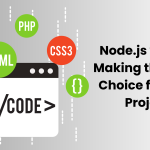A new buzz in the JavaScript community arrived in September 2023 with the name of “Bun”. Since its arrival, it has made waves among the web development fraternity. Bun claims itself to be a drop-in replacement for Node.js with advanced features and improved build times.
Is it a remarkable Node.js alternative or another JavaScript flash in the pan? What are its basics? Can we compare it with the tried-and-true Node.js or is it merely a fling? You’ll see us answering these questions in the article below. Let’s find out the crux behind Bun and discover its unique functionalities.
So, What is Bun?
Bun is a JavaScript runtime that may be used in place of Node.js with ease. It is an all-in-one toolkit for TypeScript and JavaScript apps. Bun Js includes a package manager that is compatible with Node.js, a test runner, and a bundler. Because of the integrated APIs and usage of the JavaScriptCore engine, it provides noticeable speed gains over runtimes like Node.js and Deno.

How Bun Works?
Bun runtime was developed with two goals in mind: first, to make Node.js programming easier, and second, to optimize performance whenever and wherever possible.
Bun was written in the low-level Zig programming language, which allows for a great degree of optimisation. Moreover, Bun uses the JavaScriptCore Engine — which performs better than V8 — which powers the Safari browser.
Node.js’s lack of an out-of-the-box transpiler, bundler, Typescript support, and other critical capabilities meant that installing and maintaining numerous third-party libraries and tools was required merely to execute or build a project. Bun resolves these issues and provides these features straight out of the box.
What are the Benefits of Bun?
Bun positions itself as a robust and fast solution for innovative server-side development. It makes the development process smoother, faster and efficient than ever before – and that’s what makes it unique. Some of the standout features of Bun JS include better performance, enhanced scalability and simplified syntax.
Bun is a desirable choice for both development and production contexts since its core contains a quick JavaScript runtime designed to minimize startup times and memory consumption. It is particularly useful in environments with little resources, such as serverless operations. Bun can be seamlessly integrated with pre-existing Node.js projects, with minimal to no modifications required.

The proponents of bun propel another noteworthy feature that how quickly it launches processes. Bun’s processes can launch up to four times quicker than Node.js. Bun also supports CommonJS and ES modules, meeting the needs of the contemporary trend towards ES modules while continuing to work with the vast array of CommonJS packages that are available on NPM.
A variety of APIs for jobs like setting up an HTTP server, WebSockets, Workers, managing binary data, Streams, File I/O, and more are also included in Bun’s toolbox. Among other features, it even supports TCP connections, SQLite, and foreign function interfaces (FFI).
If we are to jot down the USP’s of Bun, here is how we’ll go:
- Modern approach to server-side development
- Streamlined architecture
- Built-in features such as support for TypeScript and HTTP/2
- Built-in bundler
- Built-in test runner
- Compatibility with existing Node.js projects
- Easy to use
- Improves developer’s productivity
What are the Limitations of Bun?
Amid the furphy of Bun’s potential, some valid concerns can also be seen. Critics have raised questions on its scalability and long-term viability. Will it take over old approaches to web and programming or will the uprising settle down?
Bun’s naysayers point out that although it might provide some minor enhancements over Node.js, it’s still unclear if Bun will actually completely transform the way developers create and implement apps. They advise against writing off Node.js in favor of a recent arrival whose durability is still unknown, citing Node.js as a tried-and-true platform with a sizable ecosystem and broad acceptance.
Bun is still being actively developed, with more work being done to improve its compatibility with Node.js and its ability to integrate with different frameworks. The attraction in Bun.js stems in part from its ongoing development, which holds out the possibility of more improvements. The limitations might greatly improve and turn into opportunities to step up the game of JavaScript development workflows.
Node.js versus Bun – Who’s the Winner?
When selecting a platform, developers give top priority to performance. Node.js is a reliable and effective option for managing many concurrent connections because of its event-driven, non-blocking I/O style.

Our research indicates that Node.js has an “extensive ecosystem.” But Bun.js has made a splash in the market by prioritizing speed and performance and by using a well-designed architecture to maybe outperform Node.js. Real-world testing is necessary in this field to ascertain which platform performs best for a certain use case.
While Node.js depends on the V8 engine, which powers the Chrome browser, Bun uses the JavaScriptCore engine, the brains behind Webkit browsers like Safari. So, the discrepancy also lies in the underlying engines used by both Node.js and Bun.js.
Bun installs and manages dependencies with ease, doing away with the need for other tools like yarn, npm, or pnpm. Bun’s exceptional speed at managing dependencies eliminates the need for other tools, allowing developers to work towards their objectives more quickly and easily.
Final Verdict
In the showdown between Node.js and Bun, we can’t state a one-stop shop for all your web development needs. The choice depends on your project’s requirements, your professional team’s experience with technologies and your willingness and readiness to adapt to the disruptive technologies.
Bun is a modern technology, a performance booster and apparently a go-to substitute for Node.js and Deno runtimes. With its comprehensive feature set, unique approach for bundling, transpiling and package management; Bun seems to be quite impressive.
But is it really the case in real-life scenarios?
Well, Node.js is still a good option because of its well-established ecosystem, large community, and track record in a variety of applications. Node.js is a dependable option with a well-known ecosystem for developers starting a new project or creating real-time applications.
On the flip side, Bun.js is the wild card. It is a promising contribution in Node.js workflows due to exceptional performance. But it is still in the development phase, hence any rapid changes may be expected. We could anticipate a future of Bun as a viable replacement to Node.js – provided it gets matured, bug-free and does not require additional dependencies.
Do you fancy a detailed discussion of which one is the most stable option for your upcoming projects? Stackup Solutions has a dedicated team to explore all things related to Bun.js. Stay tuned or contact us for more exciting updates.







